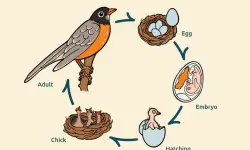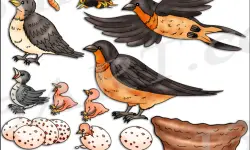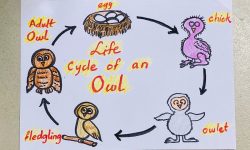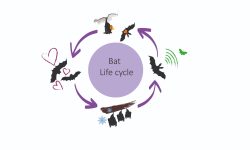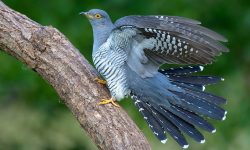Ohio, with its mix of forests, meadows, and urban green spaces, may not seem like a hummingbird hotspot at first glance. Yet each year, birdwatchers in the Buckeye State are treated to sightings of these dazzling, fast-moving jewels. While only one species nests and breeds regularly in Ohio, a surprising variety of rare visitors sometimes drop by, making hummingbird-watching both exciting and unpredictable. This guide explores the eight hummingbird species recorded in Ohio, where and when to see them, and how to identify each one.
Ruby-throated Hummingbird (Archilochus colubris)
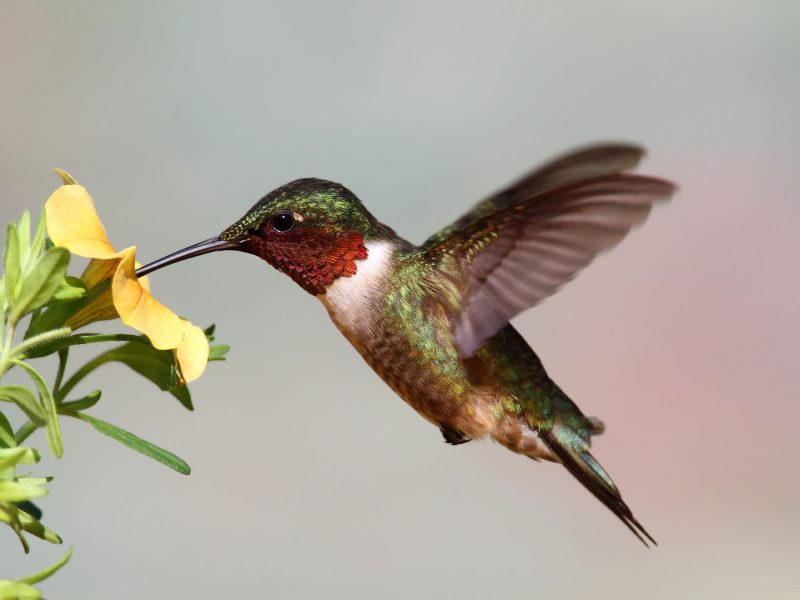
Ohio’s Only Native Breeder
The Ruby-throated Hummingbird is the only species that breeds in Ohio and is by far the most commonly observed. Males are known for their vibrant ruby-red throat patches, while females lack the bright coloration but exhibit the same rapid, acrobatic flight.
They arrive in Ohio from their Central American wintering grounds around early to mid-May and typically stay until early October. Ruby-throated Hummingbirds are found throughout the state, from rural gardens to city parks. They are especially drawn to tubular red or orange flowers and backyard feeders filled with sugar water.
Breeding season in Ohio begins shortly after their arrival in May, with females building tiny cup-shaped nests on tree limbs, often 10 to 20 feet above ground. A typical nest is about the size of a walnut, constructed from plant down, spider silk, and lichen. Females lay 1–3 eggs per clutch and raise the young alone, with fledging usually occurring within three weeks of hatching. Most nesting activity peaks in late May through July.
Despite their delicate size, Ruby-throated Hummingbirds are agile hunters. They primarily feed on nectar, which provides the energy for their fast-paced flight, but they also supplement their diet with small insects and spiders, especially during the breeding season when protein is vital. These hummingbirds often catch prey mid-air using quick darts and hovering maneuvers, or they may glean tiny insects from leaves and flower clusters.
Their favorite foods include the nectar of native plants like bee balm, trumpet honeysuckle, jewelweed, cardinal flower, and columbine. They also consume sugar water from feeders (a 4:1 water-to-sugar mix is ideal) and prefer environments with rich floral diversity and tree cover for nesting.
Best time to see: May to October
Where to look: Wooded areas, suburban gardens, nature reserves
Rufous Hummingbird (Selasphorus rufus)
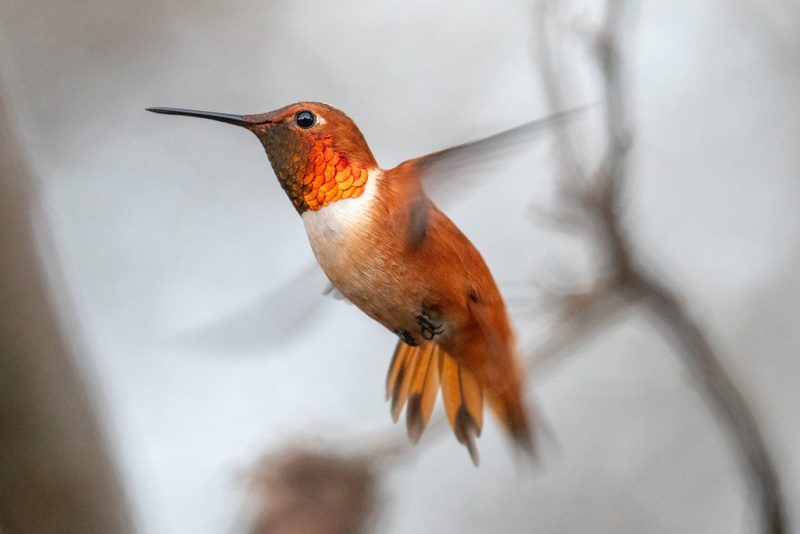
A Feisty Western Visitor
One of the most frequent vagrant hummingbirds in Ohio, the Rufous Hummingbird is native to the mountainous regions of the western United States, particularly from the Pacific Northwest to Alaska. Though not a regular breeder in Ohio, it occasionally ventures east during its long migratory journey, often surprising birdwatchers with its appearance at backyard feeders. Rufous Hummingbirds are easily confused with the Ruby-throated, but males display a more coppery-orange back and a striking iridescent reddish-orange throat.
Their native breeding season occurs in the Pacific Northwest and parts of Canada, typically from late May through July, where they nest in coniferous forests, meadows, and coastal thickets. Though they don’t breed in Ohio, some individuals arrive late in the season, often in October or November, and linger through early winter.
Rufous Hummingbirds are famed for their territorial aggression, often dominating feeders and chasing away much larger birds. Despite their tiny size, they are among the most assertive hummingbirds in North America.
Like most hummingbirds, their diet centers on flower nectar, which fuels their incredible energy demands. However, during migration—especially in colder weather—they also rely heavily on insect protein, including tiny flies, gnats, aphids, and spiders. They are highly adaptable foragers and have been observed catching insects mid-air or picking them off foliage with precision.
Their favorite nectar sources include native wildflowers such as columbine, penstemon, red buckeye, and honeysuckle, though in Ohio, they are most frequently seen at sugar-water feeders set out by homeowners. Offering feeders into November (using a 4:1 water-to-sugar ratio and keeping them unfrozen) increases the chance of attracting these rare fall visitors.
Best time to see: Late fall (October to December)
Where to look: Residential feeders, nature centers
Black-chinned Hummingbird (Archilochus alexandri)
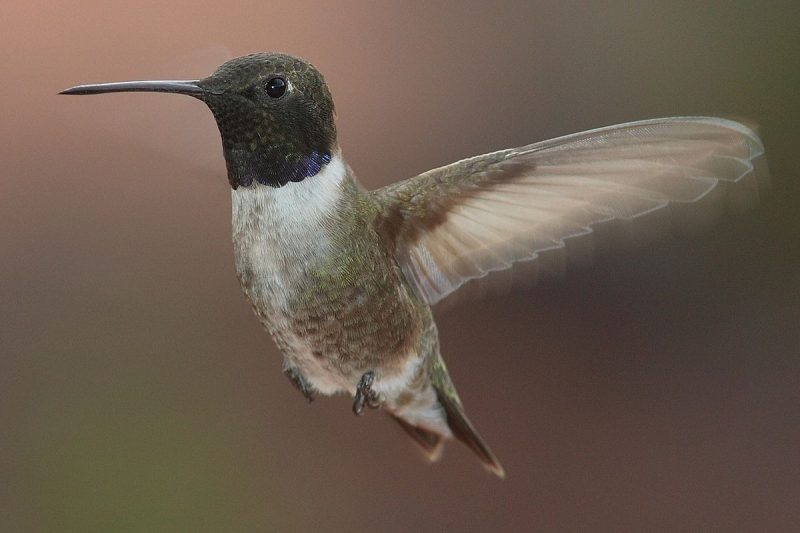
Rare but Increasingly Spotted
This species, common in the arid and semi-arid regions of the southwestern United States, is an infrequent visitor to Ohio, though confirmed sightings have gradually increased over the past two decades. Black-chinned Hummingbirds bear a strong resemblance to Ruby-throated individuals, which makes identification challenging. Males feature a dull black throat that may flash violet at the bottom in the right light, while females are nearly indistinguishable from female Ruby-throated Hummingbirds without close inspection.
Though they do not breed in Ohio, their native breeding season typically runs from late April through July in places like Texas, New Mexico, and Arizona, where they favor river valleys, deserts, and open woodlands. In Ohio, they appear only as migratory strays, most often during spring (April–May) and fall (August–October).
During migration, Black-chinned Hummingbirds are drawn to feeders and flowering plants just like their eastern cousins. Their foraging behavior includes hovering in front of flowers to sip nectar and hawking tiny insects mid-air, particularly important during migration when protein needs are high. They’ve also been observed gleaning arthropods from the undersides of leaves or spider webs.
Their diet consists primarily of nectar from native flowers such as penstemon, red salvia, and desert willow in their home range. In Ohio, they make use of sugar-water feeders and nectar-rich ornamental plants like trumpet honeysuckle, bee balm, and coral bells. Their ability to adapt to backyard environments has contributed to an increase in records across the eastern U.S.
Best time to see: Spring and fall (April–May, August–October)
Where to look: Private yards with feeders (especially during migration)
Calliope Hummingbird (Selasphorus calliope)
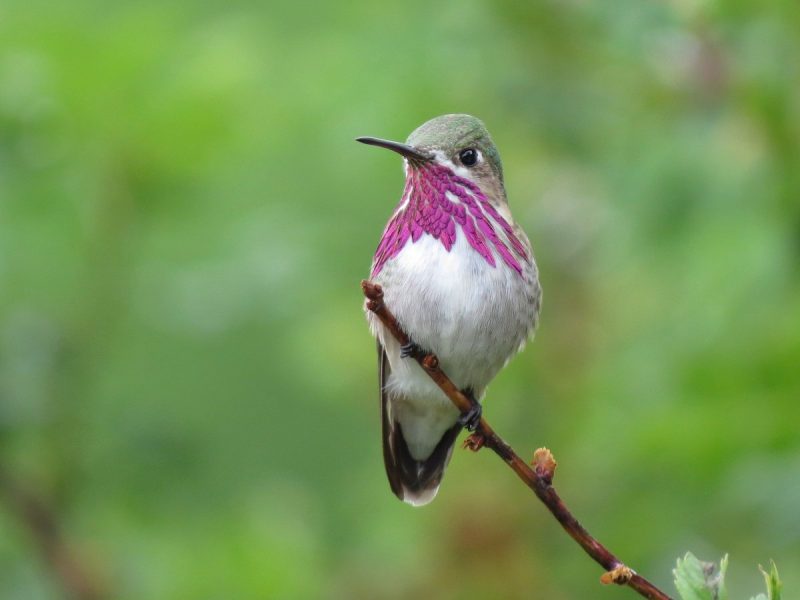
The Smallest Bird in North America
Measuring only about 3 inches long and weighing less than a penny, the Calliope Hummingbird is the smallest bird on the continent—and one of the most remarkable. Despite its size, this tiny powerhouse migrates thousands of miles each year between breeding grounds in the western U.S. and wintering areas in Mexico. While its native range is far from Ohio, a few rare individuals have appeared in the state, especially during fall migration.
Males are easily recognized by their striking starburst-like throat pattern of iridescent magenta streaks, which fan outward from the center of the throat. Females are more subdued, with a pale throat and greenish back, making them harder to identify without close observation.
The Calliope Hummingbird breeds from late May through early July in high-elevation meadows and forests of the northwestern U.S. and southwestern Canada, particularly in Idaho, Montana, and British Columbia. They build nests in conifers, often at elevations above 4,000 feet.
In Ohio, sightings occur only during migration, typically in late fall (October to November). These birds are drawn to well-maintained backyard feeders and late-blooming flowers. Though rare, confirmed sightings have occurred in both southern and central parts of the state.
Despite their delicate build, Calliope Hummingbirds are fierce and agile foragers. Their diet consists mostly of nectar, which they obtain from flowering plants, but they also consume small insects and spiders to meet protein needs during migration and breeding. They are known to aggressively defend feeding sites—especially males—even against much larger hummingbirds.
In the Midwest, they may feed from flowers like red salvia, late-season jewelweed, or cultivated trumpet vines, but sugar-water feeders are the most reliable attractant. A standard nectar mix of four parts water to one part sugar (with no red dye) is ideal for these late-season migrants.
Best time to see: Late fall (October to November)
Where to look: Feeders in southern and central Ohio
Anna’s Hummingbird (Calypte anna)
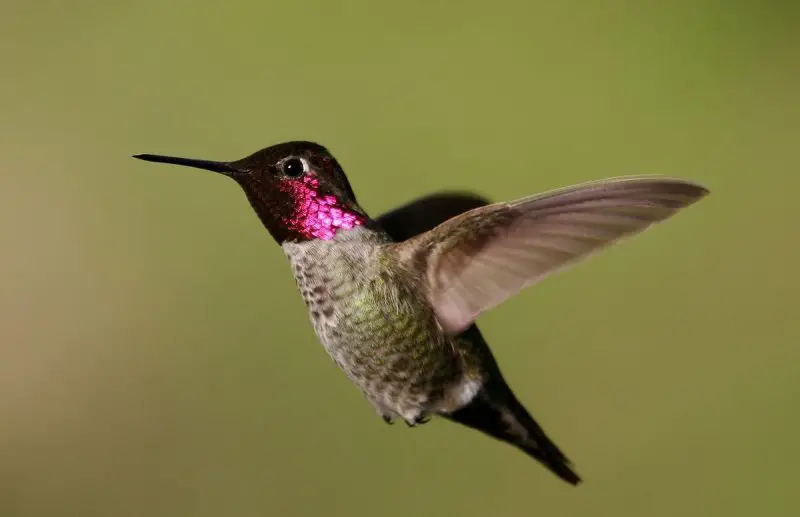
A West Coast Native Turned Explorer
Anna’s Hummingbird is a native of the Pacific Coast, originally found from southern California up to southwestern British Columbia. Over the past two decades, this adaptable species has steadily expanded its range eastward and northward, with rare individuals now occasionally venturing as far as Ohio. Though not a regular resident, these wanderers are remarkable for their endurance and cold-weather resilience.
Larger and bulkier than the Ruby-throated Hummingbird, males are strikingly beautiful with an iridescent rose-red crown and throat, which can appear dull or gray in poor lighting but glow vividly in the sun. Females and juveniles are greenish above with pale underparts and may show speckled throat markings.
In their native range, Anna’s Hummingbirds are among the earliest breeders of all North American birds, with nesting often beginning as early as December and continuing into April, even during cool, rainy weather. Their flexibility in diet and nesting habitat has helped them thrive in both natural and urbanized environments.
In Ohio, Anna’s Hummingbirds are not known to breed but are occasional winter vagrants, typically appearing between November and January. These individuals often linger for weeks if conditions are favorable and nectar feeders are maintained through cold spells.
Anna’s Hummingbirds feed on flower nectar, tree sap, and small insects, the latter being especially important during colder months when floral resources are scarce. They can often be seen hovering around feeders, shrubs, or even picking gnats and aphids from the air or leaf surfaces.
They adapt well to garden habitats, particularly those with winter-blooming ornamentals or consistently maintained feeders. In Ohio, heated feeders are essential to sustaining overwintering individuals, especially during freezing temperatures. Providing native plants like red flowering currant, columbine, or fuchsia, along with shelter from wind and cold, increases the likelihood of attracting and supporting these rare winter visitors.
Best time to see: Winter (November to January)
Where to look: Backyard feeders in urban areas
Allen’s Hummingbird (Selasphorus sasin)
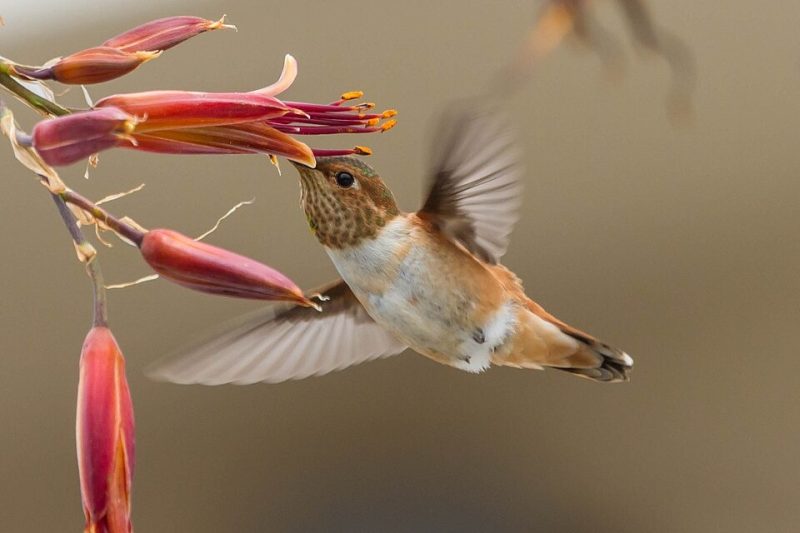
A Case of Mistaken Identity
Allen’s Hummingbird closely resembles the Rufous Hummingbird in both size and coloration, making visual identification extremely difficult without close examination—or in many cases, DNA testing. The two species are so similar that even experienced birders often struggle to tell them apart. While Allen’s Hummingbird is a native breeder along the Pacific Coast of California, only a few confirmed sightings exist in Ohio, making it one of the rarest hummingbird visitors to the state.
In its native range, Allen’s Hummingbird breeds from February through June, preferring coastal chaparral, oak woodlands, and suburban gardens. Males are highly territorial and display a shimmering orange-red throat (gorget), greenish back, and orange flanks. Females are duller and often indistinguishable from female Rufous Hummingbirds.
Though they do not breed in Ohio, individuals occasionally appear during fall migration, especially between September and November, likely blown off course during their southward journey to Mexico. These rare vagrants typically stop at hummingbird feeders where they can refuel before continuing their migration—or in some cases, overwintering if conditions permit.
Allen’s Hummingbirds rely heavily on nectar as their primary energy source but also eat small insects and spiders to meet their protein needs, particularly during nesting and migration. Their feeding behavior is energetic and assertive; males often defend feeders and flower patches aggressively, chasing away other hummingbirds regardless of species or size.
Their favorite nectar sources include native western plants like bush monkeyflower and red columbine, but in Ohio, they are most often seen visiting backyard feeders filled with sugar water. Maintaining feeders late into autumn improves the chances of attracting this elusive visitor, especially in southern parts of the state.
Best time to see: Fall (September to November)
Where to look: Feeders in southern Ohio
Mexican Violetear (Colibri thalassinus)
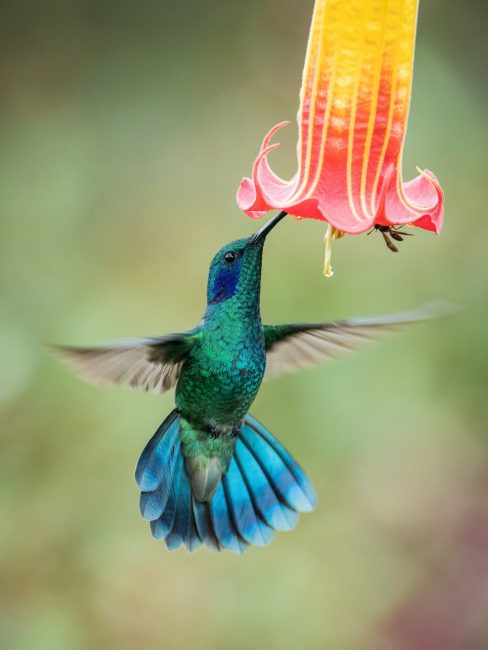
A Vibrant Tropical Surprise
With shimmering green plumage, metallic-blue overtones, and distinctive violet cheek patches, the Mexican Violetear is one of the most dazzling hummingbirds ever spotted in Ohio. Native to the highland forests of Mexico and Central America, it typically inhabits cloud forests and montane woodlands at elevations between 1,000 and 3,000 meters. Though not part of Ohio’s native avifauna, a handful of individuals have wandered far north during summer, making brief but unforgettable appearances in the state.
The Mexican Violetear’s breeding season occurs in its tropical range from March to August, with nesting activity peaking during the rainy season. Females build small cup nests in shrubs or low tree branches, often hidden within dense foliage. They lay two eggs and raise the young without help from males.
In Ohio, sightings have occurred primarily between June and August, with birds often appearing at nectar-rich flower gardens or backyard feeders. These visits are brief—sometimes just hours or a few days—likely during dispersal movements or in response to changes in weather patterns and food availability.
Mexican Violetears are strong fliers and forage using a combination of hovering and darting, allowing them to feed from flowers and capture small insects in midair. Their diet consists primarily of nectar from tubular or bell-shaped flowers, including species such as fuchsia, salvia, and lantana in their home range. When present in Ohio, they are highly attracted to sugar-water feeders and may defend a feeding territory aggressively.
In addition to nectar, they consume tiny insects and spiders, which are essential sources of protein for muscle development, especially during migration. Like most hummingbirds, they have a fast metabolism and must feed frequently throughout the day to meet energy demands.
Best time to see: Summer (June to August)
Where to look: Botanical gardens, rural areas with abundant blooms
Broad-billed Hummingbird (Cynanthus latirostris)
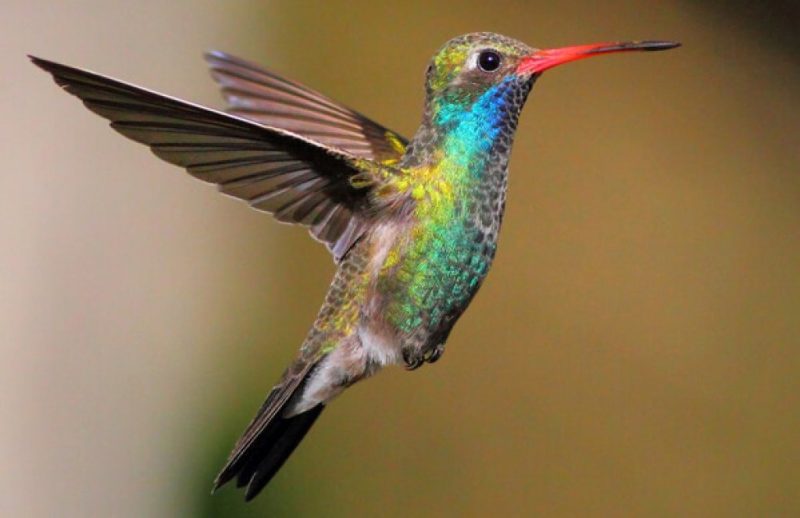
A Jewel from the Southwest
Native to the arid canyons and foothills of Mexico and the southwestern United States, particularly Arizona and New Mexico, the Broad-billed Hummingbird is among the most vibrantly colored hummingbirds to ever reach Ohio. Males are unmistakable, boasting a brilliant blue-green body, a deep sapphire throat, and a vivid red bill tipped in black. Females are duller but still exhibit greenish backs and a subtly curved bill.
This species does not breed in Ohio, but in its native range, it nests from April through July, usually near desert streams or riparian woodlands. Nests are built in low shrubs or trees, often under protective overhangs or dense foliage. The female lays two white eggs and cares for the chicks alone.
In Ohio, the Broad-billed Hummingbird is an exceptionally rare vagrant, recorded only a handful of times. Most reports have occurred during summer or early fall (July to September), likely when dispersing individuals stray far from their typical migratory routes. These birds tend to stay near backyard feeders and gardens offering continuous nectar sources.
The Broad-billed Hummingbird feeds primarily on nectar from a variety of desert and woodland flowers, such as agave, penstemon, and honeysuckle in its native habitat. In Ohio, they adapt quickly to sugar-water feeders, which provide a critical energy source during long-distance wandering. Like all hummingbirds, they also hunt tiny flying insects and spiders to obtain essential proteins, especially during migration and breeding.
Their foraging style includes hovering in front of flowers or feeders, as well as aerial pursuits of gnats and other small prey. Males may exhibit territorial behavior at feeders, but they are generally less aggressive than Rufous or Allen’s Hummingbirds.
Despite their rarity in Ohio, their striking coloration and rarity make the Broad-billed Hummingbird one of the most exciting visitors for local birders.
Best time to see: Summer or fall (July to September)
Where to look: Rare feeder sightings, usually in southern Ohio
When Is the Best Time to Watch Hummingbirds in Ohio?
The peak hummingbird-watching season in Ohio runs from early May to mid-October, with Ruby-throated Hummingbirds being the main attraction. However, the late fall months (October–December) are when rare western species like Rufous and Black-chinned tend to appear.
Installing feeders during both spring and fall migration seasons can increase your chances of attracting unusual visitors.
Tips for Attracting Hummingbirds in Ohio
-
Use nectar feeders with a solution of four parts water to one part white sugar.
-
Avoid red dye – it’s unnecessary and may be harmful.
-
Plant native flowering species like bee balm, cardinal flower, and trumpet vine.
-
Provide perching spots and avoid using pesticides.
With the right setup, your backyard might just become a hotspot for both local and rare hummingbirds.
Conclusion
Ohio may not be tropical, but it offers more hummingbird diversity than many expect. From the familiar Ruby-throated Hummingbird to the occasional wanderers like Rufous or Mexican Violetear, every sighting is a moment of wonder. Whether you’re a casual gardener or a dedicated birder, knowing when and where to look can make the difference between an ordinary afternoon and an unforgettable encounter with one of nature’s smallest flying marvels.

